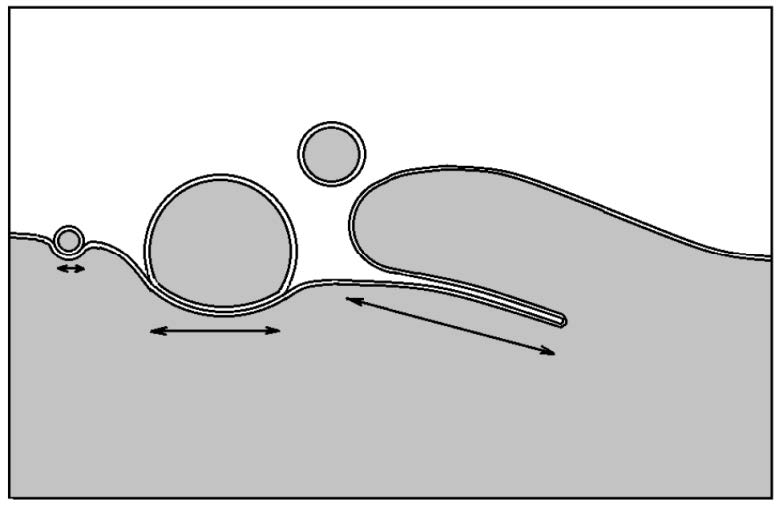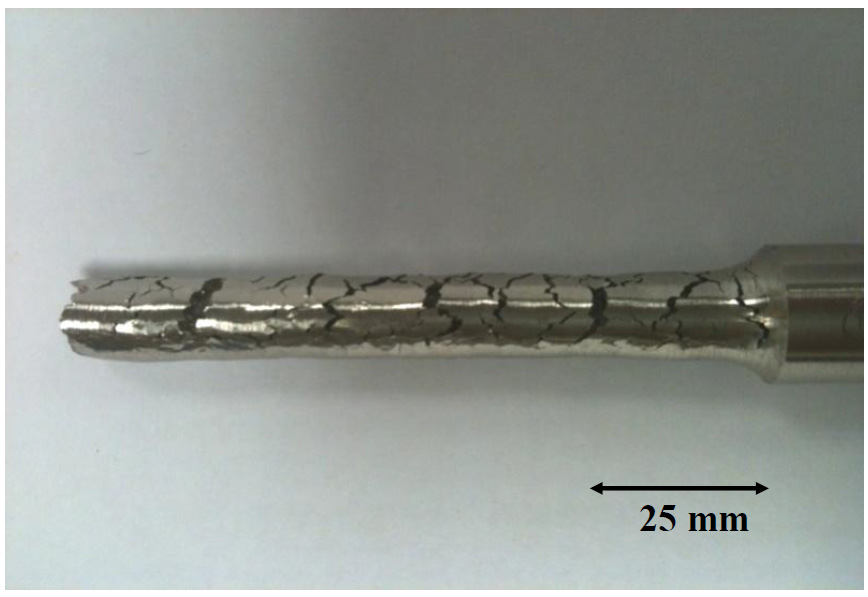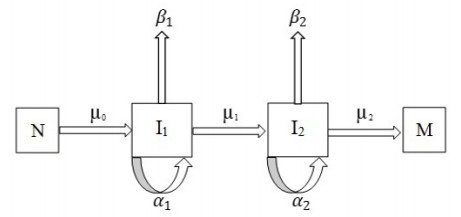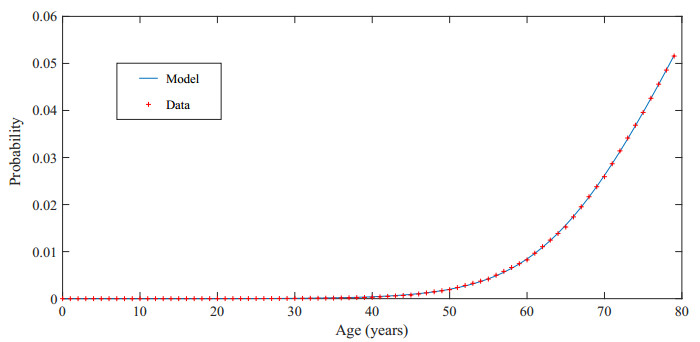1. Introduction
To open with a slightly non-serious summary of much current thinking, metallurgists have grown to assume that metals are dense, sound structures; being merely metal atoms assembled in infinite lattices, slightly interrupted at intervals by grain boundaries.
More seriously, recent studies over the past two decades have revealed this is far from the truth. In many metals a large proportion, if not all, of the grain boundaries contain pores and cracks. In addition, some cracks are not confined to the grain boundaries but travel across the grains, often following a close-packed crystallographic plane. The cracks are so thin that they are generally not observed, and have remained unsuspected.
The cracks originate from the consolidation of metals in their early processing. Powder metallurgy is a classical example of metal particles coming together, each coated with its oxide film, impinging on the film of its neighbour to create a double film. Little bonding is expected, at least initially, between these ceramic barriers, so that the double film effectively acts as a crack. Spray forming creates similar populations of defects [1].
Analogous processes occur in the liquid state. These are of greater importance partly as a result of the majority of our engineering metals being processed by melting and casting, but also because the defects created are the result of random splashes and droplets; the randomness giving rise to a much wider spectrum of defect sizes and shapes. Furthermore, this process is generally under no control (Figure 1).
When a liquid metal is poured, splashes and droplets are briefly separated and have to recombine. However, each splash and each droplet will acquire an oxide film on its surface during its short life. This period is so short that the oxide will often have time to grow to only a few atoms thickness. Thus on impingement with other drops or splashes, the two cannot combine, but create an oxide-to-oxide interface. When considering the nature of the oxide on the liquid metal surface, the underside, in contact with the liquid, is naturally completely wetted and in perfect atomic contact. In contrast, the top side of the oxide film will usually be a dry, solid ceramic surface. The impingement of these solid ceramic films forms a double film, called for convenience, a bifilm. As a result of the lack of bonding between the ceramic surfaces the bifilm acts as a crack.
Because the bifilms entrained during these turbulent transfers of the liquid metal are so thin, often measured in nanometers, they are not easily seen. However, their areas can be large, and appear to spread over a wide size range, probably from micrometers to the size of newspapers. Although they are serious cracks, their presence is usually unsuspected. They significantly affect the properties of the metal, to the extent, at times, that they control properties.
There are good reasons why some metals are free from bifilm problems, but others are definitely controlled in both their structure and properties by the presence of huge populations of bifilms.
The control of cracking in metals arises simply because, perhaps surprisingly, there appear to be no other incipient cracks in metals which could initiate macroscopic cracks. This seems to be another way of stating that there are no other sources of Griffith cracks other than bifilms. This surprising statement is justified by examining all the proposed mechanisms of crack initiation. These include the supposed, but untrue, crack initiation by dislocation pile-ups, or vacancy condensation. Similarly, the mechanism of solidification is also not capable of generating cracks (current confusion arises because bifilms are generally present to provide cracks on solidification). It seems that only bifilms appear to provide a cogent explanation of crack initiation [2].
There have been important developments in the theory of crack initiation which support the bifilm hypothesis. The first is that the Griffith theory of crack initiation and propagation from a minute initiating crack [3] is an energy model, but the model has recently been shown to run out of energy as the crack propagates, so that it appears the model is not capable of explaining the growth of cracks from initiating sites. A more recent model by Barenblatt [4,5] proposes a geometric model for which the incipient crack is a region of zero cohesion in the metal lattice, surrounded by a region of strong cohesion. This model seems capable of explaining crack propagation from an initiating defect of this kind for the first time. This hypothetical model fits, of course, the bifilm concept perfectly. Furthermore, there seems no competition from other candidates to fit this role.
Turning now to invasive corrosion; bifilms provide the obvious channels for corrodants to penetrate deep into metals. The penetration is aided by the presence of second phases which have precipitated onto the wetted outside interfaces of the bifilms (the tendency for the formation of intermetallics and second phases to form on bifilms seems common, if not actually universal [6]). As the corrodant spreads into the bifilm, the presence of second phases on the bifilm creates natural corrosion couples, accelerating the dissolution of the alloy. The presence of etch pits tends to mark the sites of the emergence of bifilms to the surface, and stress corrosion cracking and other corrosion phenomena such as filiform corrosion and blistering seem likely to be strongly influenced by the presence of bifilms.
At the present time, most of the metallurgical community is unaware of the presence of bifilms in metals. This paper is a brief review of some of the many aspects discovered so far in which bifilms control our metallurgy. Ultimately, it is to be expected that bifilms will become accepted as a key aspect of metallurgy. In a similar way to which the role of dislocations is to control plastic flow, it seems the role of bifilms is to control failure by cracking and failure by invasive corrosion. They have an essential role in the science of metals.
2. Bifilms in Engineering Alloys
The presence of alumina (Al2O3) bifilms in aluminum alloys is perhaps to be expected. This system has been widely researched, with the result that the various populations of bifilms in Al alloys is now understood in some detail. The entrapment of air inside the bifilm has been subject of elegant work showing how the oxygen is first consumed as the oxide thickens, followed by the nitrogen which forms aluminum nitride [7]. Hydrogen diffusing into the bifilm delays its complete collapse, as does, even in the absence of hydrogen, the residual 1 per cent argon in the air contributes to keeping the bifilm marginally inflated.
Magnesium alloys are similarly impaired by populations of MgO bifilms, and the various zinc alloys, and high strength brasses and bronzes, and Ni-base superalloys all tend to suffer from alumina or spinel bifilms.
The iron alloys are a complex special case.
The grey cast irons have been directly observed to owe their structure to the presence of silica (SiO2) bifilms onto which graphite (the second phase) precipitates as a favored substrate, thus forming the familiar flake graphite iron [8]. The formation of ductile iron follows from the small addition of magnesium which reduces the silica bifilms to silicon metal in solution in the alloy, and MgO. The bifilms are therefore instantly eliminated and particles of MgO, apparently together with some sulfur, form particulate nuclei for the precipitation of graphite in a spheroidal form [6].
The steels are yet more complicated.
Many steels contain some Al or Cr which give rise to alumina or chromia bifilms during the pouring of such steels. Even the small Al addition for deoxidation can be sufficient to create alumina bifilms. These steels are therefore expected to be noticeably impaired by the presence of a large population of bifilms.
However, the high temperatures required for the melting of steels lead to further complications of this simple bifilm creation regime.
1. The solid oxide films are so thin, having a high surface energy compared to their volume, that they are subjected to the energy reduction mechanism of coarsening, a variety of Oswald ripening. This diffusion-controlled mechanism for the fragmentation of a film into separate particles is elegantly modeled by [9]. However, although the severely damaging crack formed by the bifilm has now been transformed, the remnants of the void remain permanently in place in the form of the residual argon bubbles. Inclusions are often associated with pores for this reason, and such volume defects are possibly the only reason why inclusions are able to nucleate other volume defects such as pores or cracks.
2. The high temperature may melt the surface oxide film if the chemistry of the film is right. A liquid surface film on the liquid steel cannot produce bifilms, since the impingement of drops and splashes during surface turbulence of the steel simply assimilate, the liquid oxides joining to form liquid oxide droplets which quickly float out. Those droplets which did not manage to float clear would be trapped to form spherical oxide inclusions. The efforts of those researchers targeting “inclusion shape control” [10] mainly by the inclusion of Ca together with the Al deoxidation to create the low melting point eutectic between CaO and Al2O3, were unwittingly pursuing the goal of converting the surface oxide on the liquid steel from solid to liquid.
The Hadfield 13Mn steel enjoys a surface oxide MnO2 which is liquid at casting temperatures. Its consequent freedom from bifilms after casting confers unusual resistance to cracking. The alloy is noted for its toughness in highly stressed applications such as rail crossings.
The boron steels are also not easily explained, because the addition of the order of 0.005B is so much less than the 0.1 to 0.5C addition required for predictable metallurgical changes. However, its action in the microscopically thin surface oxide to convert this to a molten borate, with a melting point of less than 1000 °C, can explain its absence of bifilms, and thus its excellent strength and toughness [11]. The enhancement of properties of our existing steels by boron additions to create a liquid surface film during casting would be expected to be a largely unexplored way forward to the creation of improved steels. The improvements might be expected to be additive to those achievable by alloying or heat treatment.
To summarise the position for steels, a few have solid oxide films which will form bifilms, and whose properties will be seriously degraded. Others will have modified bifilms which will have evolved into:(i) arrays and “stringers” of small, separate, coarsened particles, whereas (ii) those with liquid films will have developed into spherical droplet inclusions. All varieties of entrained oxide inclusions, no matter how subsequently evolved, will be expected to retain its residual crack or pore, filled with hydrogen and/or argon, which will form the volume defect from which a future crack can initiate.
Even so, steels suffer much less harm from entrainment defects than Al alloys, partly because of the high temperature transformation of the defects into less harmful forms, but also from the greater density difference between the steel and its oxides, encouraging the rapid floating out of entrained oxides. This contrasts with Al alloys in which entrained bifilms have nearly neutral buoyancy so that bifilm populations tend to be retained during the time available for processing. For these reasons, Al alloys commonly achieve percentage elongations only in single figures, whereas steels enjoy elongations in the region of 50%.
Ni-based alloys are extraordinarily similar to Al alloys. Their lower processing temperatures compared to steels ensures that their bifilms remain unchanged, thereby maximising damage to properties, as illustrated in the test bar shown in Figure 2.
3. Casting Technology
Our current casting technology, particularly for shaped casting and ingots, but also to some extent applying to the continuous casting process, usually involves the pouring of metals through heights of well over a meter, when it is known that a fall of only about 10 mm can result in entrainment of the liquid surface [6].
Furthermore, throughout the casting industry, pouring is nearly always funnelled into a conical pouring cup, or “trumpet”. This venturi shape acts as a superbly efficient air pump, ensuring that the high velocity liquid metal can be mixed with up to 80 per cent air. This bubbly mixture is ideal for maximizing the formation of bubbles and bifilms, the major entrainment defects. At this time, the conical entrance feature to the filling systems when casting metals is universal, regrettably resulting in universally gross entrainment of defects in our metals. It is not surprising that our steels contain such dense populations of inclusions, many of which are bifilm cracks or their evolved descendents. Alarming reports of “thousands of cracks” in a reactor pressure vessel are perhaps, therefore, to be expected [12].
The author expends much effort into promoting two proven engineering solutions to the entrainment problem with current casting methods:
1. Contact pouring. The technique is applicable to the current methods of pouring under gravity, but simply involves avoiding any air gap. This involves the minor inconvenience, which is easily overcome, of having to align the nozzle from the pouring ladle with the entrance to the pouring channels for the cast product. Eliminating the air makes a vast difference to the cast product [11]. However, casting under gravity always involves some damage to the liquid because gravity accelerates the liquid to velocities which are not wanted with the result that some residual air is always entrained. In passing, we should note that current techniques claiming to reduce air entrainment using various mechanical and argon shrouds are clearly inefficient. Only a direct and firm contact between the ladle and sprue entrance is truly effective.
2. Counter-Gravity Casting. The ability to fill the mold quiescently, at a velocity under the control of the casting engineer, transforms the casting operation. If the melt never once folds in its own surface, the casting process will never introduce a single bifilm into the product. The counter-gravity technique therefore has the potential to deliver defect-free metal products. There are many examples of the benefits of counter-gravity filling of molds. For instance, the 300 kg steel railroad wheels cast by the Griffin foundries in the US enjoy a failure rate below 1 in ten million. Similar rates are achieved by the tiny 20 g rocker arm castings for General Motors [12] cast by Hitchener Corporation. In the case of the Al alloy cylinder heads for racing car engines cast by the Cosworth Process fell from 50 per cent failures to zero overnight when converting from gravity to counter-gravity filling of molds [14].
The above technologies are not costly, nor difficult. They are required changes for the casting industry to reduce its current densities of defects in metallurgical products. The metallurgical and engineering worlds will be transformed by these necessary and very basic upgrades.
4. Conclusions
1. Bifilm are double oxide films, effectively folded face to face, and acting as cracks. Bifilms are to be expected as a natural result of nearly all consolidation processes, including powder metallurgy and spray forming. However, it is especially important when formed during the surface turbulent events during the melting and casting of metals, particularly during pouring.
2. Whereas dislocations are necessary to explain the plastic flow of metals, bifilms appear to be necessary to explain the initiation of fracture in metals.
3. With a number of notable exceptions, dense populations of bifilms degrade most of our current engineering metals and alloys.
4. Bifilms can be avoided by either (i) chemical alloying to provide a liquid surface oxide on the surface of the liquid metal during casting, and/or (ii) improved melting and casting techniques designed to avoid entrainment of the surface of the liquid metal.
5. Bifilm-free metals promise a new generation of metals which will have the capability to resist failure by fracture and failure by invasive corrosion.
Conflict of Interest
The author declares no conflicts of interest regarding this paper.










 DownLoad:
DownLoad: 





